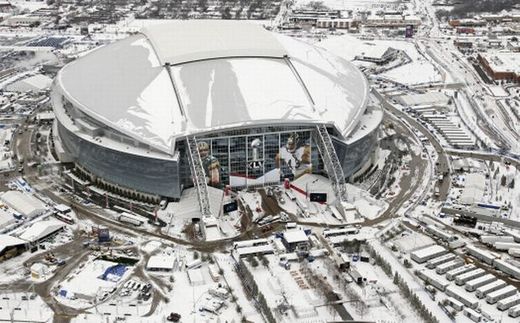
© Louis DeLucaCowboys Stadium and the surrounding area are blanketed by snow on Friday.
As bowling ball-size chunks of ice fell on him from the roof of Cowboys Stadium on Friday afternoon, Win McNamee said he didn't think he would survive.
"Honestly, while it was hitting me, I was thinking I'm going to die here," McNamee said. "It was pretty frightening."
McNamee, a veteran photographer who works for Getty Images, was one of six people injured by falling ice outside the site of Sunday's Super Bowl XLV in Arlington. He broke his left shoulder in four places and was planning to fly home to Washington, D.C., on Saturday and undergo surgery soon.
None of the other injuries were thought to be life-threatening, authorities said. One person remained hospitalized in stable condition Friday evening, officials said.
McNamee said he was at the stadium to take snow-related photos when he heard what sounded like jet engines and spotted an "avalanche of ice."
"I had nowhere to go," he said. "It hurt pretty bad."
At an unrelated news conference within hours of the incident, NFL Commissioner Roger Goodell was asked what would be done to address the safety hazard.
"They've already had, I believe, a helicopter going around identifying the areas where this could be an issue," Goodell said. "The likelihood is they'll have to get somebody up there to get the snow off as soon as possible, so they likely will be doing that in the next 24 hours."
The injuries were reported about 1:15 p.m. after ice and snow fell from the southern area of the stadium roof.
Huge sheets of ice and snow atop the stadium could be seen sliding off the dome and crashing 200 feet to the ground as temperatures warmed and the sun reappeared.
Authorities initially said one of the victims was "critically" injured, but they later backed off that report.
Lt. Pedro Arevalo, spokesman for the Arlington Fire Department, said ice falling from the roof of Cowboys Stadium was not something authorities had dealt with in the past and therefore wasn't something they had planned for.
"All this stuff just keeps getting thrown at us, but we've been prepared and we're ready for these types of situations," Arevalo said.
He added that authorities were confident they had the potentially dangerous areas of the stadium blocked off and that people could get in and out safely.
The accident forced officials to shut all but one stadium entrance.
"All stadium entrances have been closed except for the truck tunnel, which is away from the building by a very safe distance," NFL spokesman Brian McCarthy said in an e-mail. "All workers and visitors will now enter and exit through the tunnel until further notice."
In December 2009, two men working on fabric roof seams slipped on the icy roof of the stadium. They slid 250 feet before stopping at the edge.
The men crashed into a gutter, preventing them from falling over the side, authorities said.
McNamee, who has covered at least a dozen Super Bowls, said he didn't expect his time in North Texas to be life-threatening.
"I covered a war, I covered the stuff in Haiti last year. You always figure if something is going to happen, it would be in one of those places - not at a football game," McNamee said.

Reader Comments
to our Newsletter